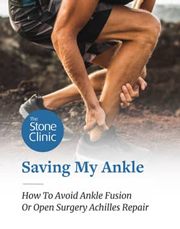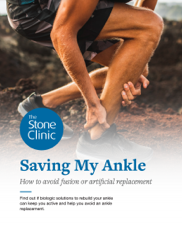The Great Achilles Debate
To repair or not to repair the Achilles tendon? That is the question. Here is the answer.

Our bias is to repair it if:
You want to retain full strength, normal tendon length, minimal scarring, and confidence in your athletic performance. But choose repair only if your surgeon can perform the percutaneous procedure. This is done without opening the skin, using resorbable sutures, with healing augmented by injections of PRP, and paired with a rehabilitation and fitness program guided by an excellent therapist and fitness trainer. Here’s why.
An unrepaired Achilles heals with scar tissue at an elongated length. The tendon, having been pulled apart, is stimulated to lay down new collagen and fill the gap created by the rupture. Over time, the scar tissue can remodel into tendon tissue that is good enough but longer than the original. The muscle to tendon to bone connection is distended, which is why the calf is somewhat weaker than a normal (or repaired) tendon.
A tendon repaired through an open incision loses the normal synovial sheath that covers all tendons (this is because it cannot be effectively closed in the swollen tissue environment). Though the healing after an open incision can be superb, there is an unfortunate incidence of excessive scarring, infection, and stiffness. And an open Achilles tendon surgery takes a year to recover fully from—ask Kevin Durant.
The percutaneous technique that we favor involves making six puncture holes, through which two resorbable sutures are passed in a fashion that crisscrosses the torn tissue. When tied, the ends of the tendon are brought together. This allows healing of the collagen fibers to occur at their normal length. The repair is augmented by injections of growth factors both at the time of surgery and during the recovery period. Starting on day one after surgery, a careful range of motion and rehabilitation program is initiated. This includes soft tissue massage to the injured leg, balance exercises, and well-leg cycling. An upper body and core strengthening program is designed so that the athlete, during their healing time, is increasing their fitness rather than losing it. Weight training is progressed so that full weight bearing on the injured leg occurs by six weeks.
Over time, the repaired Achilles hypertrophies, increasing the volume of the tendon tissue, so that on an MRI the tendon looks thicker than normal. This persists for years. But re-rupture is rare. By not using any permanent sutures, not opening the tendon sheath, and not losing the natural healing blood clot that forms over the torn ends of the tendon, the risks of infection, foreign body reaction, scarring, and weakness are diminished.
So while large studies show minimal differences between repaired and unrepaired Achilles tendons—meaning that many health care plans won’t cover operative repair—it is our belief that those studies are not focused on athletes who want to recover better and stronger than they were before their injury. In our opinion, there is no debate.
A Double Achilles Injury Patient's Story Comparing Percutaneous Repair to Open Surgery
This squash player shares his unfortunate, but unique experience of having each of his Achilles tendons repaired with different surgical techniques: one performed with open surgery with another surgeon and the other with the percutaneous Achilles repair technique by Dr. Stone.


